Lazio’s 3-1-5-1 Build-Up Approach
Simone Inzaghi & Lazio enjoyed a hugely successful 2019-20 season, with a Supercoppa Italia to their name and achieving domestic qualification for the Champions League for the first time in five years. The way in which they did so was equally impressive, scoring the 3rd highest goals in Serie A with Ciro Immobile the centrepiece of their attacking prowess.
However, the most intriguing aspect of their success is the use of a 3-1-5-1 formation allowing them to create an array of strategies to penetrate and progress past the opposition, particularly within a congested yet overloaded central area. The rationale of this piece is to explore this systematic approach in depth and consider its adaptations against diverse opposition strategies.
Building Play from Deep
The sensible starting point would to be consider how Lazio build their play from defensive areas, providing a tactical foundation to enable them to penetrate beyond the opposition’s midfield. As displayed below, Lazio’s creation of in possession play begins with the formation of a diamond consisting of their back three and Lucas who plays the point down of the midfield unit. The intricacies within this outline Lazio’s intentions, Lucas often has a closed body orientation limiting him to play back to the back three when possession is with the central centre-back, potentially allowing the opposition to use this as a trigger to press with the knowledge that possession will go backwards. However, if half-backs (outside centre-backs) are in possession he will position himself half-way between the half-back and centre-back, with his body orientation becoming partially open creating the opportunity to play into wing-backs (implying that play out will be funnelled wide through outside centre-backs rather than centrally). Meanwhile, the central centre-back in Acerbi stays deeper to invite the outside central-defenders to push higher and wider using the half-space as much as possible, whilst the depth of Lucas in relation to the rest of the midfield ensures defensive security should possession be lost with Radu or Felipe.
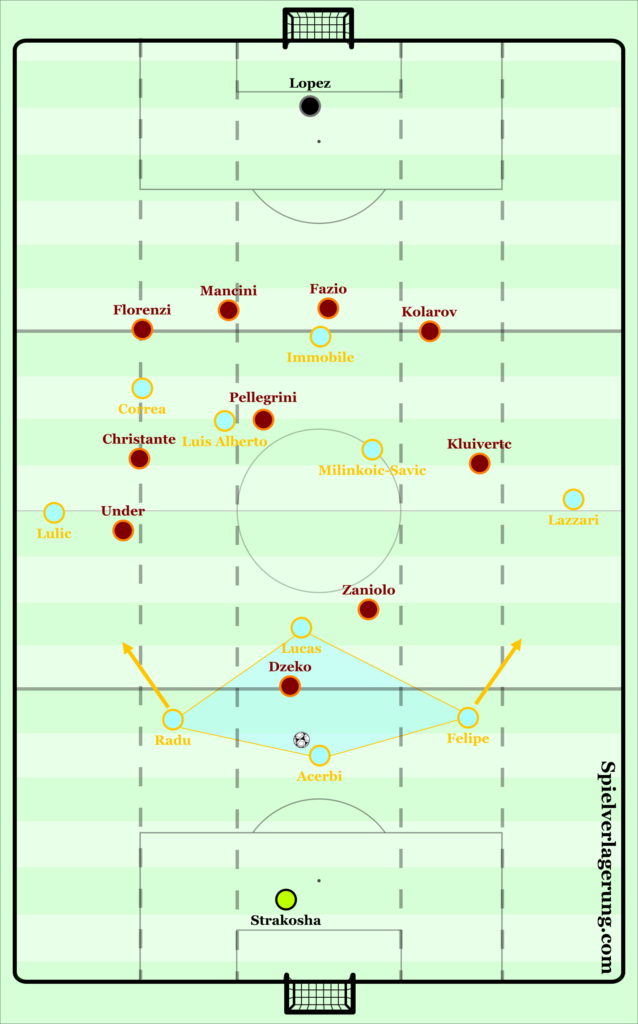
Click on images to enlarge them.
However, the importance of this set-up ensures that Lazio’s defensive unit can progress into midfield by stepping into play by switching possession between themselves across the pitch until they can cut out the opposition’s strikers, in this instance a lethargic press from Dzeko and Zaniolo combined. Although, this is limited and increases in difficulty dependent upon the level of high pressure applied by the opposition, to be highlighted further in latter segments. The detail on this switch of play is integral, with Acerbi frequently being “missed out” to increase the tempo of the switch and to avoid the second man press from Zaniolo who is in a position to travel upon him should possession be switched along the floor, this allows Felipe (or the opposite outside centre-back) to break the attacking press and create an overload with the opportunity to play into the high positioned 5v4 midfield corridor in the second graphic below displaying the follow-up action of switching possession against Roma. This was enabled by the passive nature of Dzeko’s press, though Acerbi does drop deeper to provide support from behind to switch out across through the opposite centre-back should the opposition striker be more aggressive and attempt to curve his pressing run to restrict Lazio.
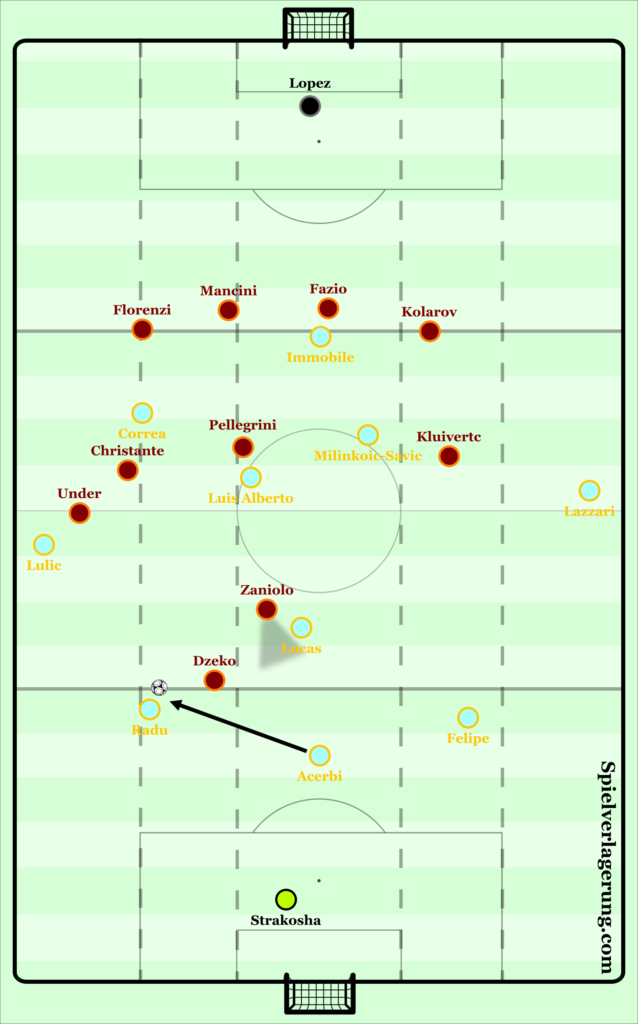
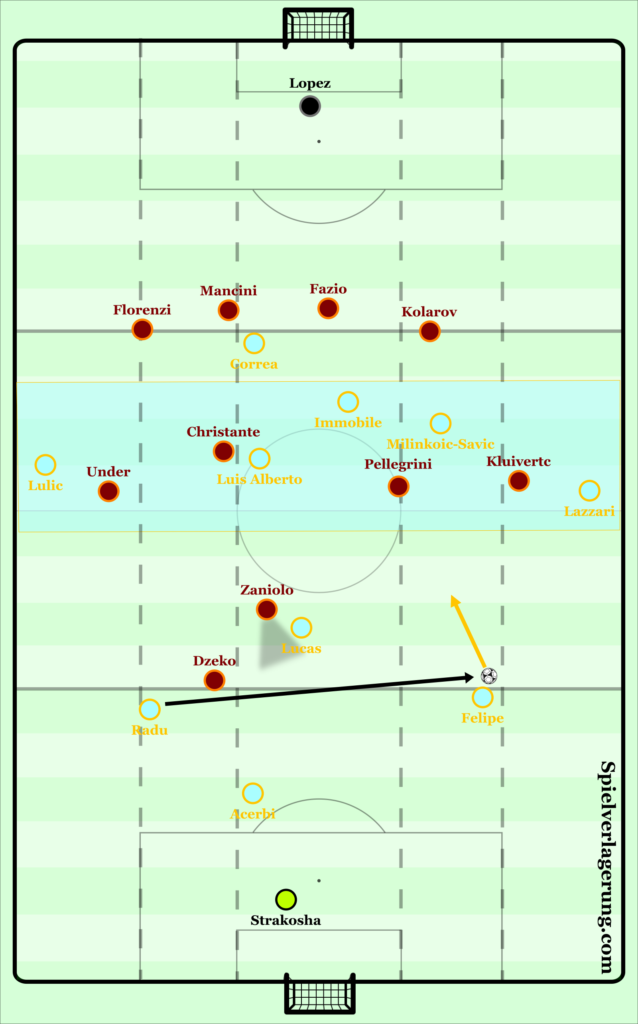
Although, this apparent ease to escape opposition pressure is not consistent within all of Lazio’s matches, as displayed by the stresses caused by Juventus’ high pressing approach. As shown in the below graphic, Juventus’ resting 4-3-1-2 became a 4-3-3 within the high press with Bernadeschi transitioning from a 10 into a 9 in order to press Acerbi. As a result, the near-side wing-back and near-side midfielder (Lulic & Luis Alberto) had to drop much deeper than their usual starting position in order to support possession with pressure applied to the entirety of the back line. The consequences if they did not would have meant the distance between themselves and the ball player was too vast and prevent Lulic & Luis Alberto providing an alternative strategy should Dybala & Bernadeschi’s pressing angle restrict passes back inside. Meanwhile, on the opposite side the picture is of stark contrast with Milnkovic-Savic taking an extremely high position to restrict Matuidi’s pressing ability upon the switch of possession. If Milinkovic-Savic alternatively maintained a deeper position it would then open up the opportunity for Matuidi to front-screen Milinkovic-Savic whilst occupying a closer distance to Lucas and Lazzari, presenting a domino effect enhancing the viability for Ronaldo to be more aggressive and potentially allow Juventus to press 3v3 against Lazio’s back line (this would significantly restrict Lazio’s opportunity to play out). Whilst within the picture portrayed below, Matuidi is locked into a deeper position as if he moved out it would provide the opportunity for Lazio to play a pass into Milinkovic-Savic, breaking two lines in the process. It is within these intricate positioning details, that Lazio’s strategy poses depths of intelligence. With Bernadeschi curving his run to restrict play to the left half of the pitch and a pass into Radu, Dybala then engages with an aggressive straight pressing run to force a pass outside with the aim of completing a regain of possession through a third pass pressing system utilising a double-press upon Lulic (Pjanic & Ronaldo ensure cover by retaining a position to prevent Luis Alberto & Lucas receiving).
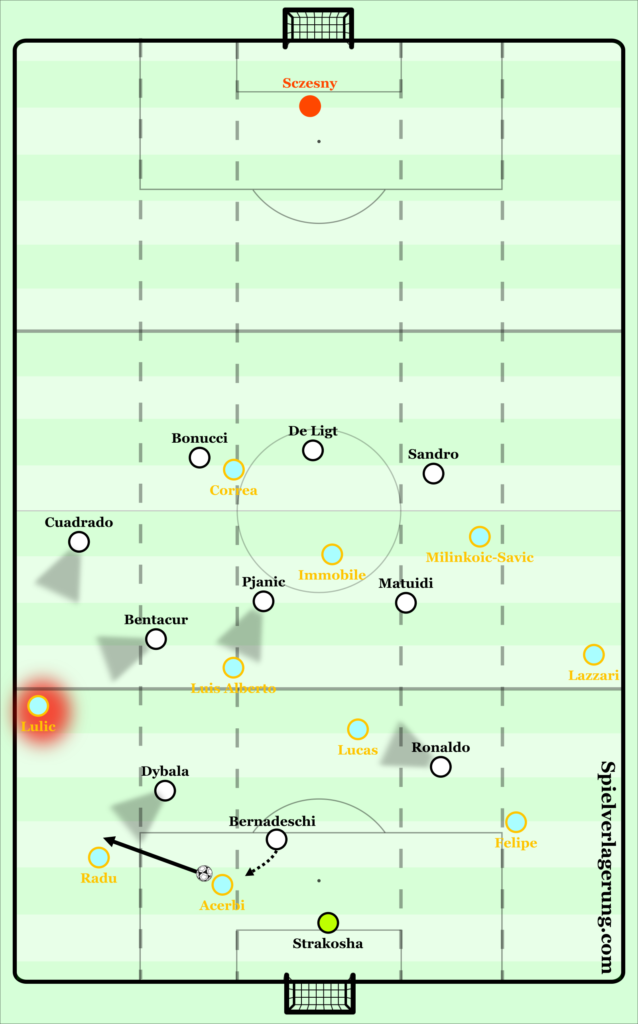
However, with Lazio clearly anticipating this approach they switched possession back through Acerbi (who dropped deeper to support from behind) and subsequently Strakosha with evident intensity in order to play directly into Lazzari at right wing-back, with the speed of play preventing Juventus’ midfield three from covering the necessary distance to defend this effectively. As a consequence, the press is broken and Lazio have successfully created an overload using a supporting diamond to play beyond the midfield line of their opponents. The role of Milinkovic-Savic is integral within this, his high starting position alongside Immobile dropping in prevents both Matuidi and Sandro from pressing whilst the pass is travelling onto Lazzari (as detailed previously), as they are outnumbered and have no option but to attempt to delay Lazio’s play (pressing would simply provide a more penetrative and dangerous option to play beyond the defensive line). Furthermore, from this scenario Lucas uses the pass as a trigger to support play in front of Pjanic enabling him to play round the corner into Immobile off the front foot to break Juventus’ midfield line and set Immobile in attacking transition, whilst other combinations remain available via the “supporting diamond”. Once again illustrating Lazio’s insistence to play out from the back in order to create spaces in-between the opposition’s lines to combine and create.
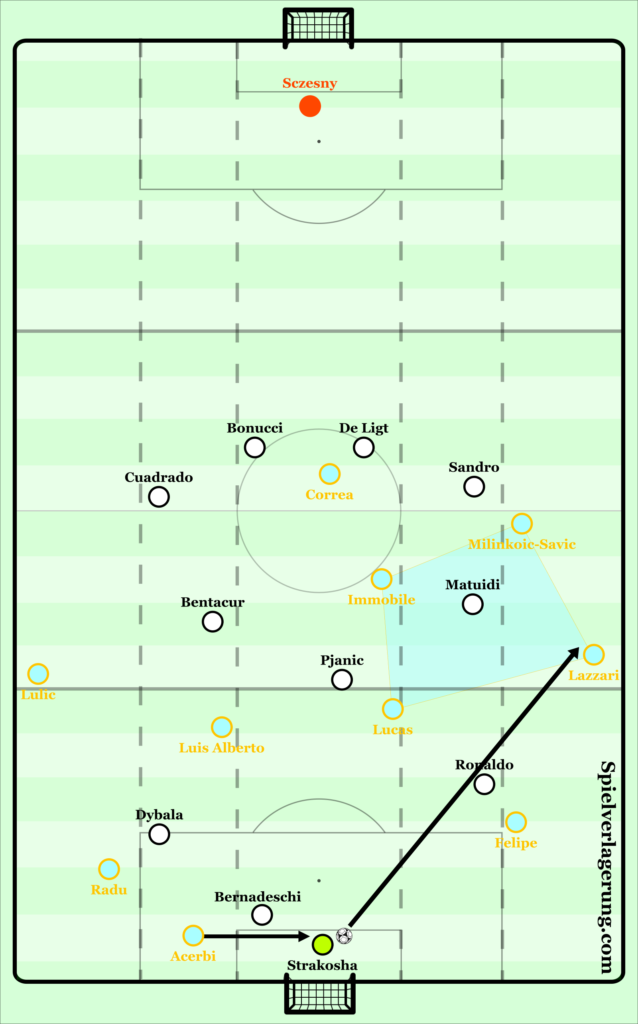
This isn’t to say Lazio’s back-line stay within their seemingly structured back three, at times they have adapted to create a double-pivot using one of the central-defenders (often Acerbi) in order to play around the opposition, most prevalently to open up deeper passing lanes to switch possession horizontally. The pre-requisite for this is a trigger of a switch of possession to and from outside centre-backs via the goalkeeper, with the intention of dragging one of the opposition’s forward line away from providing intense pressure upon Lazio’s back line. A useful approach it would seem to combat opposing teams with a back 3, who possess the subsequent ability to lock out Lazio both in central and wide areas, by opening up the opportunity for Lazio’s centre-backs to step into midfield and create the overload required to bypass the opposition. This can be perceived within the below graphic, with Inter adapting to an almost 5-4-1 shape from their resting 3-5-2 in order to combat Lazio’s approach to play out. The outside central-midfielders (Vecino/Barella) are intended pressers upon Radu/Felipe respectively in order to prevent play into central areas by front-screening with their pressing runs. Whilst Brozovic retains a position of cover and balance to travel upon Milinkovic-Savic/Luis Alberto should pressing runs from Barella/Vecino be inefficient and Martinez drops deeper to front-screen Lucas from receiving as the point down. The aim from Inter’s perspective is to regain possession by forcing play out wide or long with 1v1s upon wing-backs and three physically dominant central-defenders. However, Acerbi steps into the midfield line upon the trigger of the pass from Strakosha into Radu (also feasible to use the reverse of Strakosha into Felipe) to provide the potential for dual outcomes to break Inter’s press by affecting Lukaku’s movement.
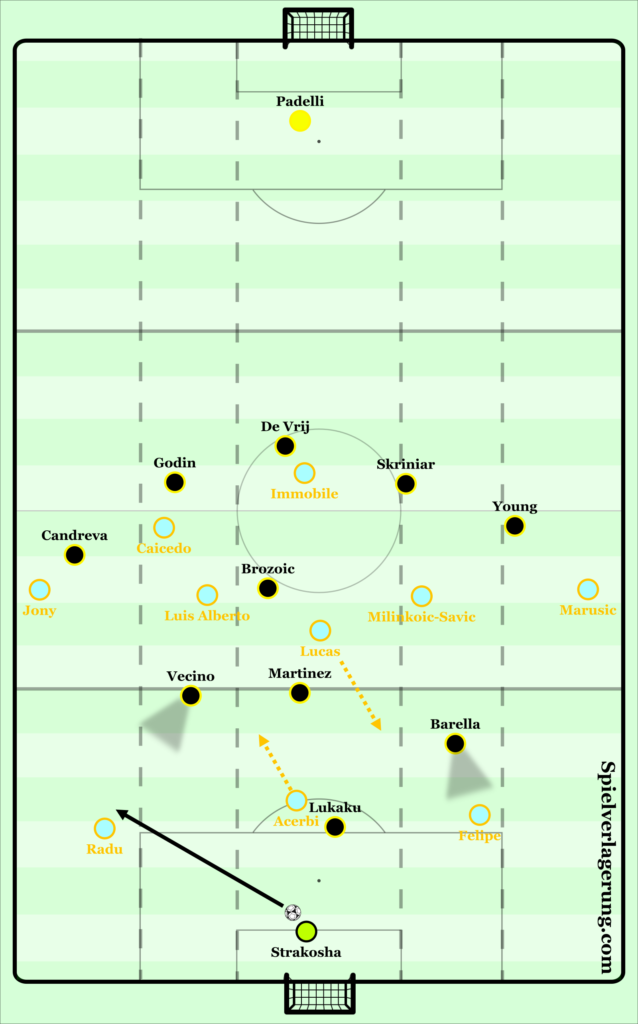
In the first instance, the most beneficial outcome for Lazio would be for Acerbi’s forward 3rd man run to be untracked by Lukaku, allowing a direct pass into Acerbi who creates a central midfield overload with a 4v3 against Brozovic/Martinez/Barella (even a 4v2 should Barella not recover effectively). Even if Vecino presses so aggressively to prevent this pass at the first opportunity, Lazio retain the option to play via Jony to bounce possession back inside off the front foot to Acerbi and thus the same scenario is created. From this, due to Milinkovic-Savic’s position beyond the back shoulder of Brozovic (the deepest of Inter’s midfield line) a pass can be played between Martinez and Brozovic to once again break the midfield line and create an attacking transition. Once again, this positioning of Milinkovic-Savic is a vital component of Lazio’s strategy as his position enables penetrative breaking of the opposition’s midfield line. If he was deeper and in front of the opposition’s deepest midfielder it would provide Martinez/Barella a greater opportunity to front-screen and Brozovic the chance to travel upon a pass into him, whilst also giving Inter the chance to delay Lazio’s attack and allow players behind possession to recover and reinstate a more compact defensive structure.
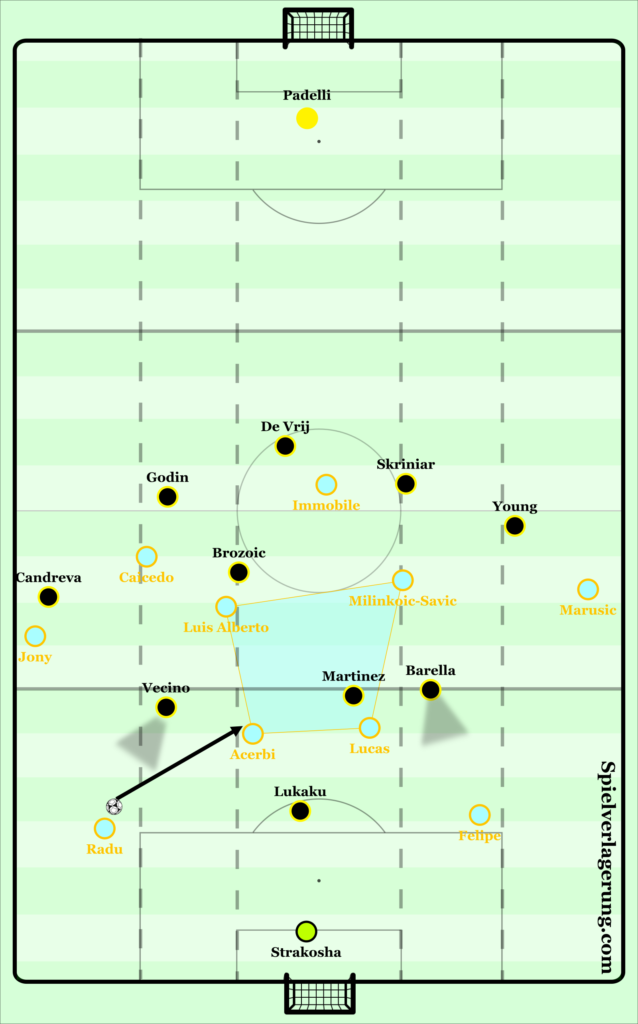
Despite this, as a secondary outcome even if Acerbi is tracked, it provides the opportunity to switch possession in deep areas without any direct pressure from Lukaku. This enables, as displayed in the graphic below (much as within previous patterns), Lazio to switch play with speed and intensity into a 2v1 with Felipe/Marusic against Barella which on this instance found Marusic at right-wing back who can then combine with support in front from Milinkovic-Savic to break the midfield line. Further to this, Immobile also drops in as the near-side striker to create the subsequent midfield overload whilst Caicedo becomes the highest man.
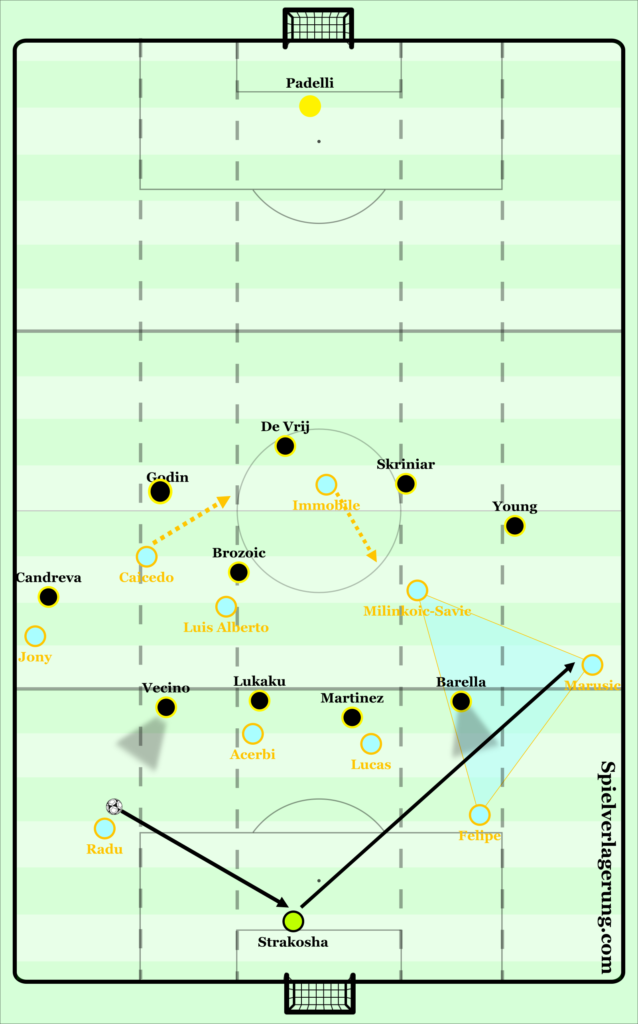
It is also useful to highlight that although rare, Lazio have played long in some situations. However, there are often clear signs within their second and third line that this eventuality is going to develop. Within a preferred line-up, the only real height Lazio possess is through Milinkovic-Savic making him the focal point of direct play with additional 3rd man runners utilising a direct pass as a trigger to exploit spaces. The clearest example of this is against Atalanta, who pressed with a locked-on man-man approach against Lazio’s back 3 restricting them from receiving to play forwards and rather simply forcing any passes into the back 3 straight back to Strakosha. In order to do so, Atalanta had to be particularly aggressive and push Masiello almost into the midfield unit to mark Milinkovic-Savic, leaving a 2v2 should Lazio’s attacking-midfielder and striker both decide to stay high.
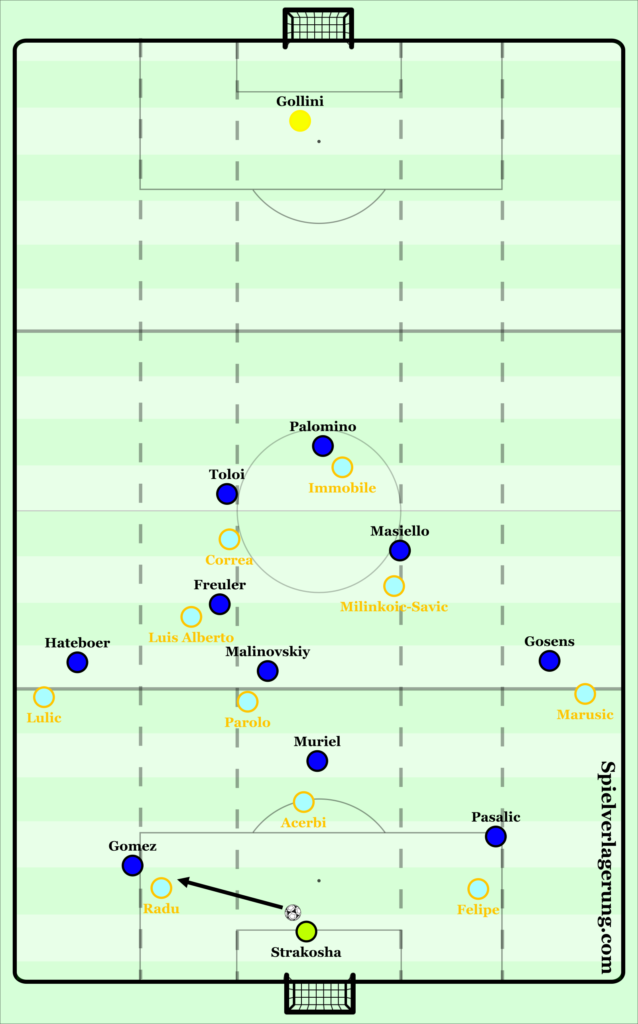
The trigger that often identified this as a pattern of play was Acerbi making a run to whichever side possession was played (e.g. across towards Radu upon possession returning back to Strakosha). An unlikely outcome would be that Muriel fails to follow Acerbi providing an opportunity to break the press with a simple pass beyond the first line. If this occurred, then Lazio would have the opportunity to play forwards past Atalanta’s midfield line with Acerbi creating a one man overload due to Atalanta man-orientated pressing approach. Although the most likely outcome even though it may seem trivial, is that Muriel follows Acerbi which opens up the space in front of Strakosha upon possession being played back into him which allows a longer driven pass to potentially be played into midfield should any of the three (Parolo/Luis Alberto/Milinkovic-Savic) be in a position to receive to feet. It also simply reduces pressure upon the ball, likely leading to an increased quality of distribution. This would create the scenario where Lazio break the first and potentially second line of the press dependent upon where these players receive, albeit in a different manner to seen before. Although, rather the chosen option upon returning possession to Strakosha was to play a direct floated pass into Milinkovic-Savic who makes a higher forward run upon the trigger of the pass back to Strakohsa. Using this as a trigger, the four closest players create a surrounding diamond around possession, providing necessary height, width and depth upon the second ball. The aim is for Lazio to regain in a high area, providing them with the opportunity to break into attacking transition should it be successful. The follow up-actions available can be seen by the 3rd man runs made upon the direct pass, a successful flick on to Immobile in-behind or to Marusic in wide areas creates a direct opportunity to progress beyond Atalanta’s defensive line by exploiting the space. However, securing possession more centrally with Correa or Parolo opens up the opportunity to combine in tight areas with a significant number of players in close proximity creating an overload.
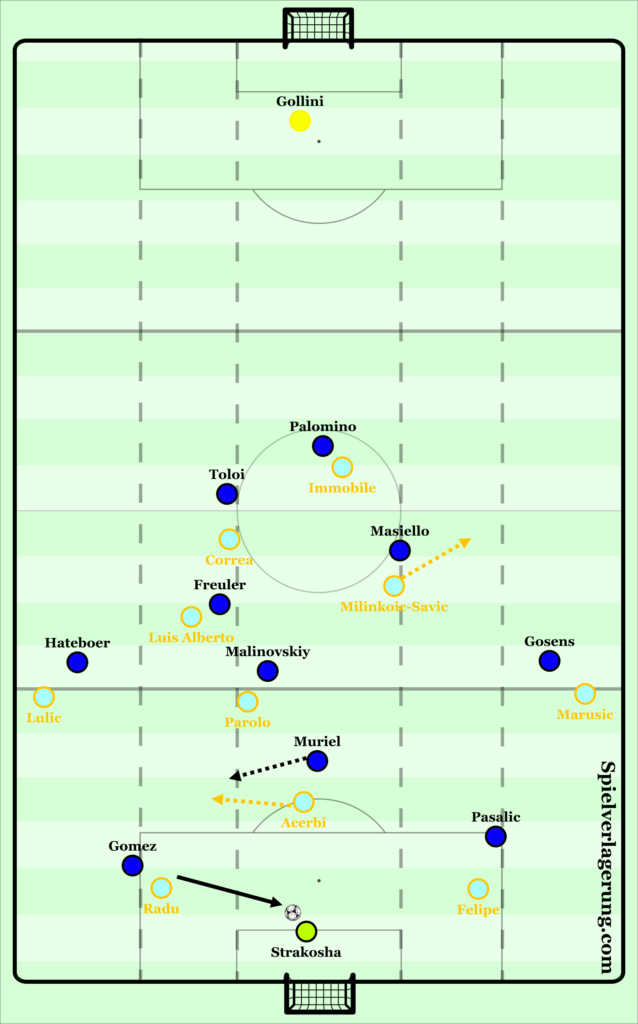
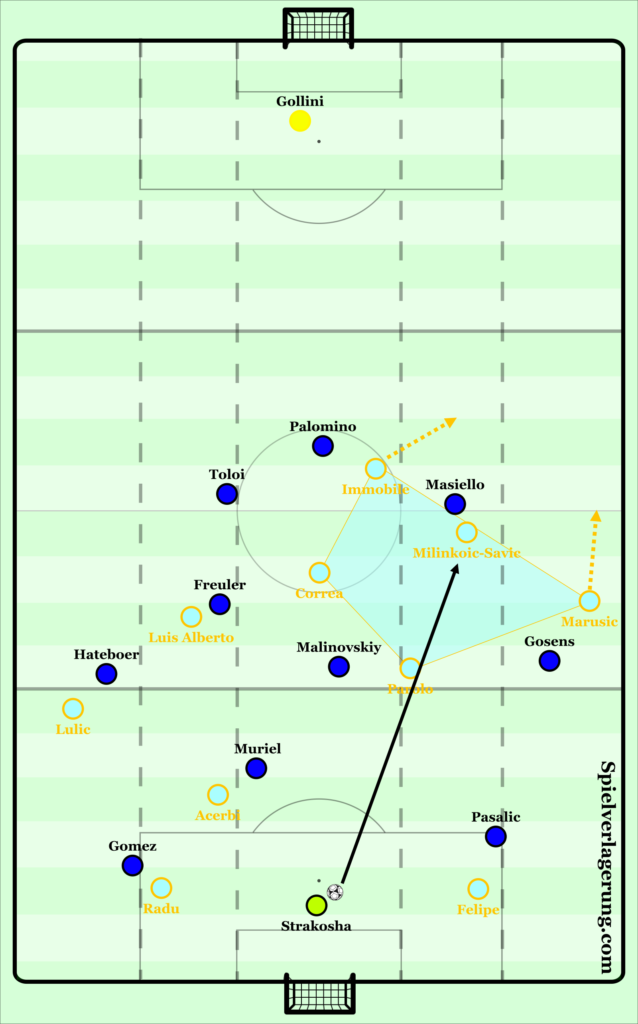
Using the “3-1-5-1” to Penetrate Midfield Lines
Given that we now have a base understanding of how Lazio build up within their defensive third, allowing them to play into 6 man midfield consisting of a deep lying Lucas and versatile attacking midfielder in Correa/Caicedo (though there is frequent rotation between this attacking midfielder and striker), it would be pertinent to consider how Lazio use this to progress and create opportunities.
The first aspect as alluded to briefly within the prior section is Lazio’s midfield positioning, it is important to consider that the midfield unit consists of a point-down, two central-midfielders and an attacking midfielder to create the highest point of a central midfield diamond in effect, as well as wing-backs on either side. The clear benefit of the system is the central overload it creates against almost any opposition strategy, strengthened further by one of Lazio’s back-line being able to step in as a result of deep build-up play. Once Lazio are in a position to play into midfield (as detailed by the approaches before), the observable distances between the point-down and the other three of this midfield diamond are stark, in order to create a vacated space between them. It has already been explained that Lucas (point-down) is integral in deeper build up play with a predominantly closed body orientation, meaning progressive possession has to be played into the remaining trio within this central diamond if central penetration is to be successful. This is exemplified by the graphic below, with Lazio’s 3-1-5-1 lined up against a congested central 4-2-3-1, emphasising how the 3-1-5-1 creates the opportunity for an extra man (would also account for other 3 man midfields dependent upon their pressing approaches).
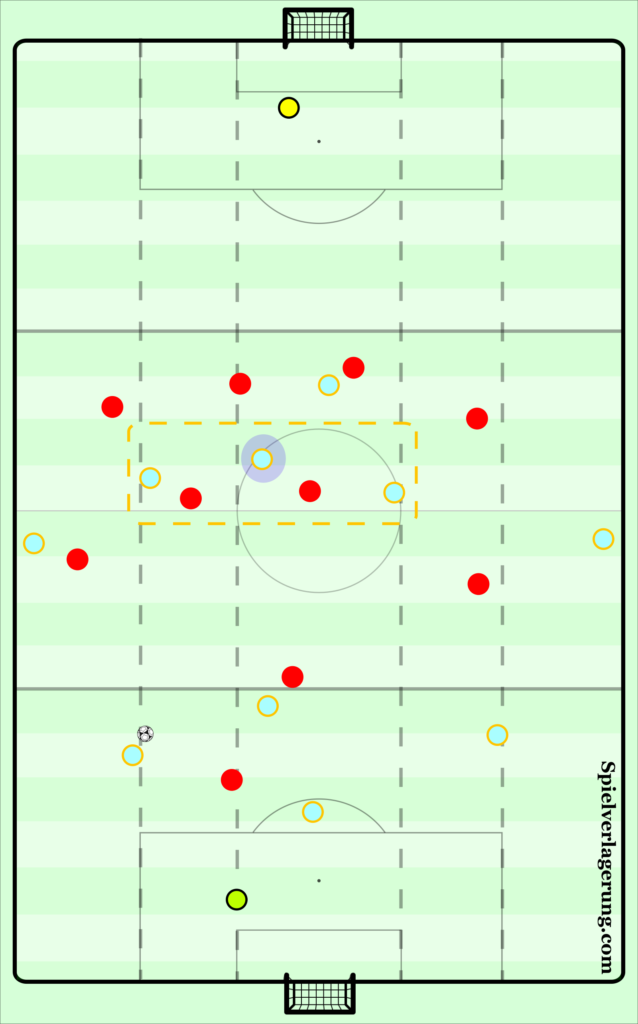
The technical advantages of this start position from a receiving context are clear, all three players are in a position to receive beyond the opposition’s midfield line and their individual marker’s back shoulder making it both possible to break a line with a successful pass and making it more difficult to track their movements. Additionally, their body orientation remains open so that upon receiving possession they can break and create attacking transitions instantly. Once the centre-back in possession steps into midfield and draws a player out, this only increases the potency of the central overload with at least one passing lane open due to the attacking-midfielder creating the extra man. Upon the trigger of a successful pass, wing-backs and the remaining striker can make forward runs beyond the opposition’s defence presenting a transition that allows to go from build-up to an attacking 5v4 within one pass.
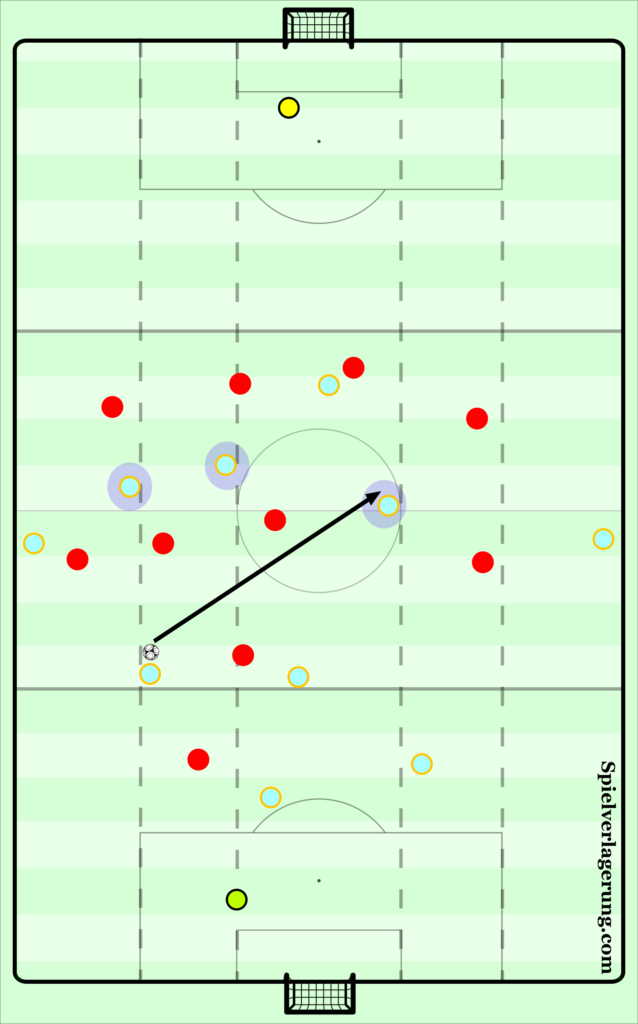
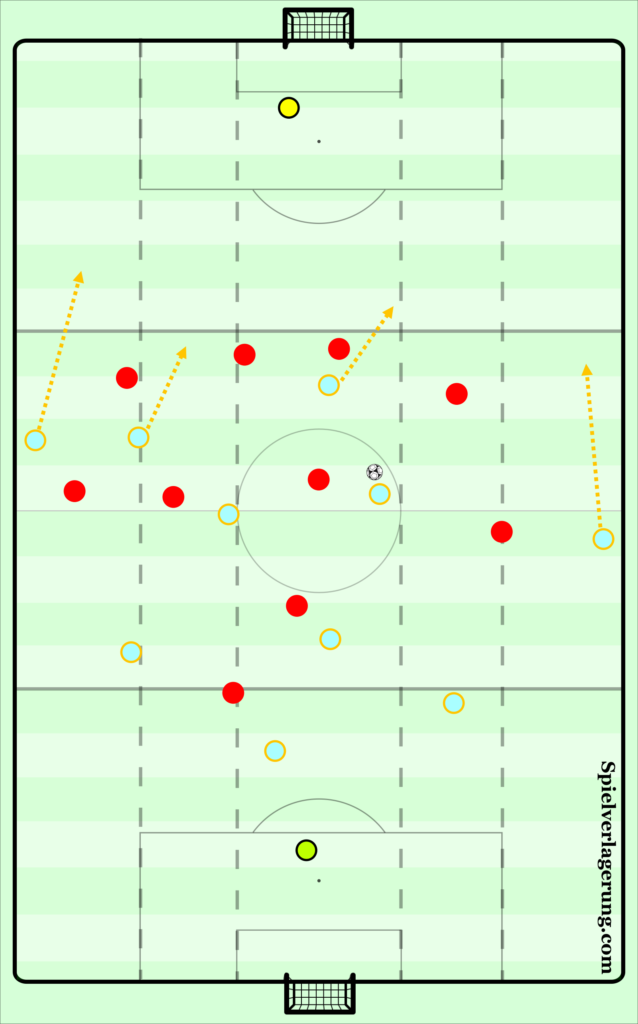
Take the example of Lazio’s first goal against Parma (below) as the undeniable benefits of receiving details in this context. The prior pass to the first graphic below was a pass back into Strakosha, so there can be an appreciation of the high pressing approach used by Parma in an attempt to restrict Lazio from playing out from the back. Within Lazio’s midfield line, you can clearly identify the strategy they attempt to employ with Lucas dropping deeper who takes the attention of both Brugman & Barilla in this instance, whilst Parma’s third central midfielder in Hermani had gone to press with Kulusevski doing an inadequate job of narrowing off and restricting central space. If Parma had been able to provide this central cover, Lazio would have been discouraged from playing the vertical pass and thus highlights the defensive priority of retaining a compact central structure against Simone Inzaghi’s team. However, with Parma failing to even have three front-screening midfielders as a minimum that would partially protect from this second line pass, Strakosha can play directly beyond Parma’s second line into the cleverly positioned Luis Alberto, who receives at least 5 yards behind the back shoulder of Brugman with an open body orientation as to open up the opportunity to play forwards quicker which creates more space in behind Parma as they have less time to retreat. It is also important to consider at this time the position of Milinkovic-Savic & in particular Correa who has dropped off and on another occasion any of this trio could be the receiving player perhaps combining between them before playing forwards. Instead, upon the trigger of Luis Alberto receiving the players ahead of him all make different forward runs to create space for a penetrative pass in beyond Parma. Correa makes a curved run as to retain the option to receive with the ball ahead of him to split Pezzella & Alves, Lulic makes a straight run that is enough to occupy the momentary attention of Darmian thus creating the space for Immobile to make a curved run to receive between Darmian & Iacoponi. The pass is duly played through and Immobile finishes as he did consistently throughout the 2019-20 season, yet more importantly shows Lazio’s vertical passing prowess with them being able to play beyond Parma & score within two passes.
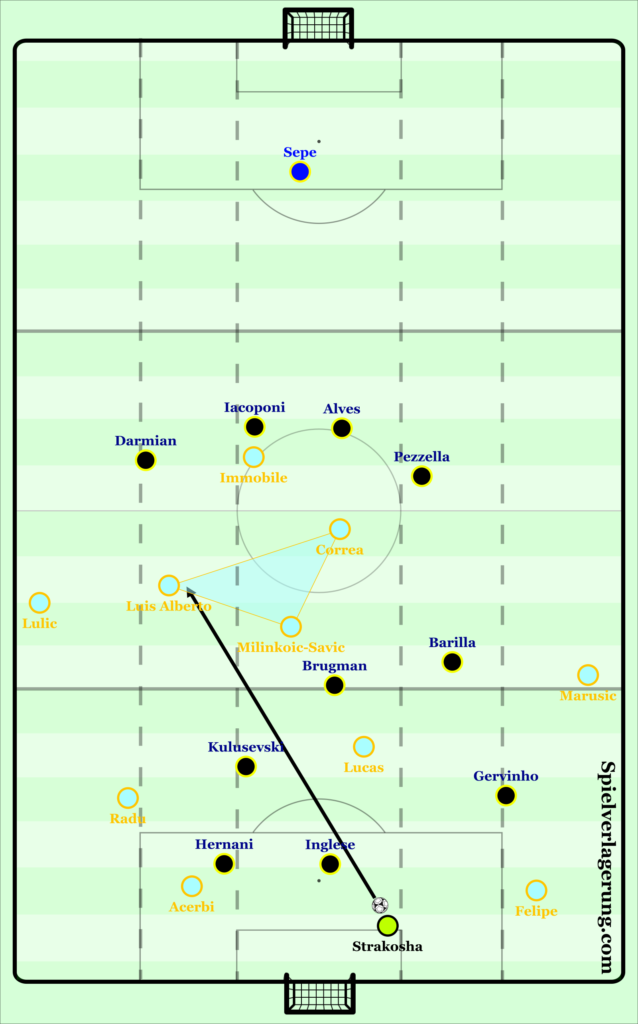
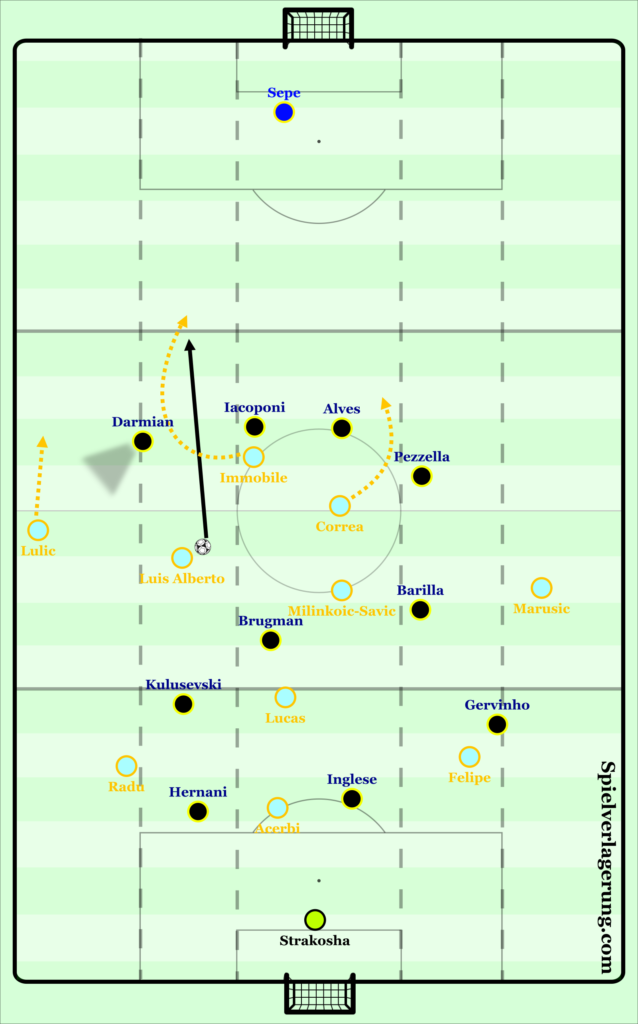
The height of Lazio’s midfield also poses problematic outcomes for the opposition even should they successfully attempt to screen the passes into the trio beyond the midfield line or even drop deeper to retain goal-side protection on Lazio’s midfield. The high start position creates a vacated midfield space that can be dropped into receive at any time, a habit that Luis Alberto most frequently fulfils, creating an opportunity for players to drop deeper (often untracked due to their blind-side starting position) and act as a “quarterback” with a lack of pressure upon them allowing longer distanced passes to be played over the oppositions defence. It is important to highlight within this that the striker and opposite wing-back will make forward runs beyond the opposition’s defence upon the trigger of a midfielder receiving within the vacated space, allowing quick and direct penetration.
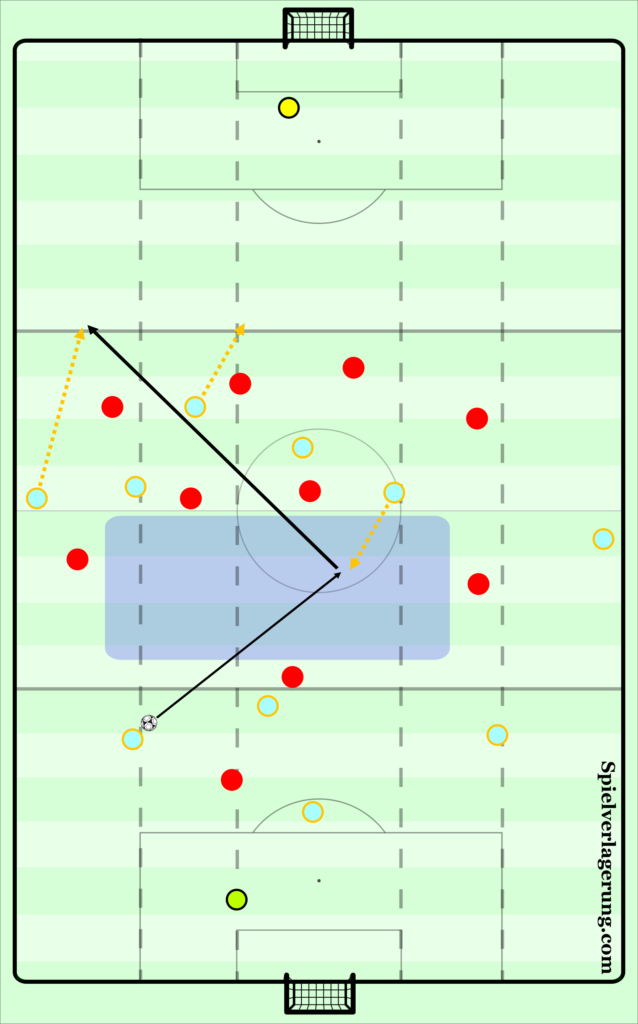
The application of this is perceivable with Lazio’s second goal against Juventus demonstrated below before & after receiving possession, it is important to present the caveat that Juventus did only have 10 men at the time, though this arguably would have made it even more difficult for a penetrative pass as they dropped deeper into a low block. As shown, with Acerbi maintaining secure possession in the first graphic, Luis Alberto, Milikovic-Savic, Immobile and Correa are all positioned beyond Juventus’ midfield line as you would expect. However, Immobile has dropped deeper in rotation with Correa to disrupt Juventus’ rigid defensive structure with Milinkovic-Savic unusually high for general play, though he does have a tendency to position himself higher in anticipation of more direct play. This creates the vacuum of space mentioned previously from which one of these players can drop into, whilst also in this scenario Lazio’s full-backs are especially aggressive with their positioning enabling these midfielders to drop into an almost “false full-back” position to receive possession (this is not a common theme, but one that was clearly imposed due to the state of the game, ultimately paying off). This is exactly the action that Luis Alberto takes, he makes an sprint to receive 10 yards in front of Emre Can to ensure he is un-tracked from his starting blind-side position, with Can’s lack of 360 degree awareness preventing him from following and applying pressure. This is used as a trigger for the already high positioned Milinkovic-Savic to make a diagonal run behind both De Ligt and Bonucci, who are unable to track effectively once again due to the blind-side nature of the run, whilst Correa and Immobile stay in deeper positions to retain the attention of De Ligt and Bonucci in order to split their attention and create additional space for Milinkovic-Savic to expose. Upon receiving in behind, Milinkovic-Savic controls superbly and slots beyond Sczesny to put Lazio 2-1 ahead. Once again, this enables Lazio to employ a vertical passing strategy with high rates of success, though the technical superiority of Luis Alberto is a huge factor within this.
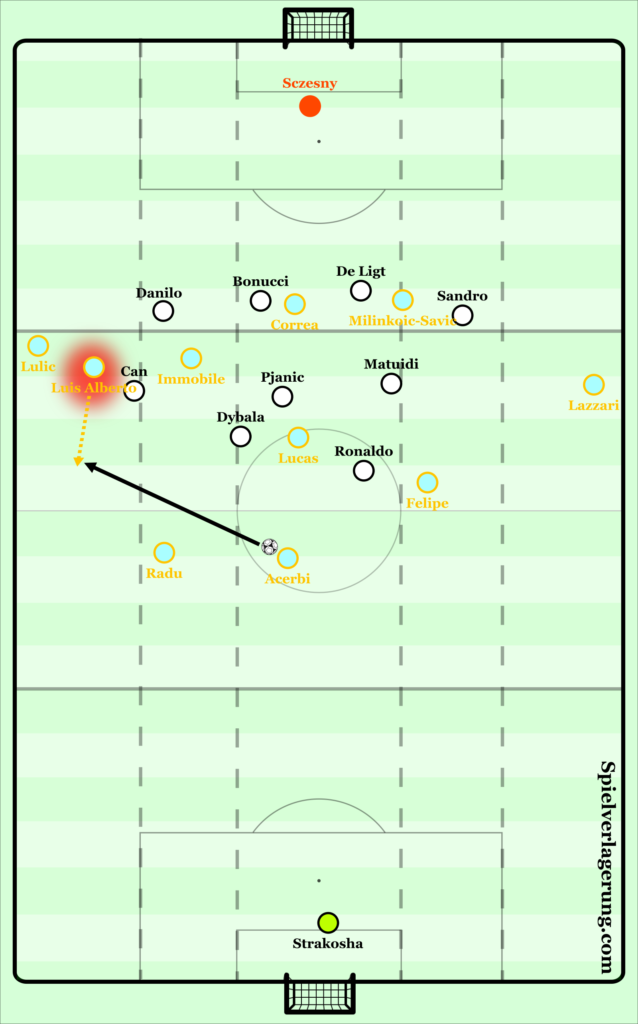
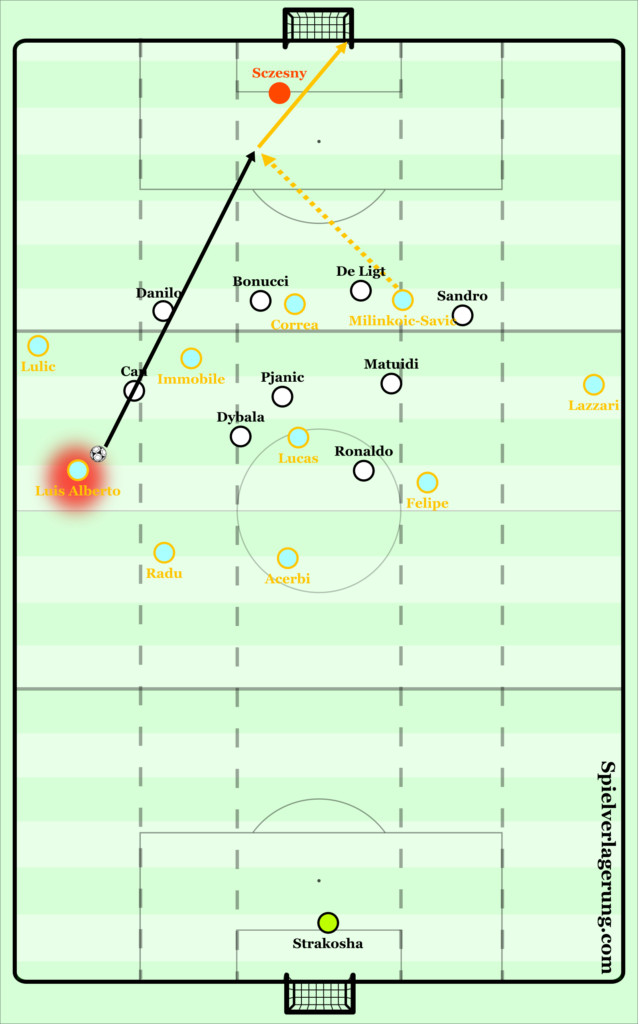
The above positioning of Luis Alberto as a “false full-back” should not be surprising to an extent, as it is a rotation (Lulic & Luis Alberto rotating) that Lazio have looked to use to unsettle the opposition, especially when playing against more rigid structures who look to mark spaces as opposed to players. Although, it is one of the rare examples of a horizontal rotation of positioning, with most positional rotation occurring on vertical lines between Luis Alberto, Milinkovic-Savic, Immobile and Correa. This has been evident throughout the piece so far, with examples of Immobile and Correa dropping deeper than Lazio’s midfielders frequently and Milinkovic-Savic demonstrating a freedom to often roam beyond Lazio’s attacking line. Nonetheless, the representation of Luis Alberto and Lulic’s horizontal rotations is an important consideration of the strategies Lazio can extend to should their central vertical play be unsuccessful.
This does lead nicely into the role in which the wing-backs and relevant near-side central midfielders (Luis Alberto & Milinkovic-Savic as No.8’s) have to play in the penetration of opposition midfield lines as well. The strategies within this section so far have focused primarily upon penetration through the central lanes, whereas Lazio do have the ability to penetrate the opposition through the shrewd creation of 2v1s in wider areas utilising wide No. 8’s and wing-backs against opposing wide players, this becomes more prevalent once the opposition begin to narrow off to prevent central penetration (as it is a higher defensive priority) as more spaces becomes available in the widest lanes and outside of half-spaces. This is conceptually shown below against medium block 4-5-1 (emphasising the central congestion that would act as a trigger to exploit wider areas). As possession is secure within central areas with the deep single pivot (would be Lucas) and with the opposition congesting the central lanes to force play outside, the No. 8’s (Milinkovic-Savic/Luis Alberto) pull into a wider position, from a narrow starting position to deceive the opposition, to receive on the outside of the opposition’s widest central midfielder (there is flexibility as to whether both players do this, which would stretch spaces to receive in-between via the AM/CF and perhaps create additional opportunities to play centrally if Lazio wished, or whether only one moves out to retain an element of unpredictability in their play). As a consequence, this allows a 2v1 to be created against the opposition’s wide players, the distances are too large for the near-side opposition full-back to press as they are within a medium block whilst opposition centre-backs are occupied with the movement of Immobile/Correa. If the same situation was provoked under a low defensive block, it would become more perceivable for the opposition to defend effectively due to the opposition’s full-back’s closer proximity enabling them to travel upon to both the No. 8 and wing-back to press. It is important that on a micro-level, Lazio’s wing-back and near-side No. 8 in question play off differing diagonal lines to maintain the opportunity to combine for second phase actions, with the below example displaying a combination beginning with the full-back for Lazio to progress beyond the opposition’s midfield line. Once this has been successful, there are a variety of future actions, though the below example presents a direct opportunity to vertically penetrate the opposition’s defensive line through a forward run between central-defenders.
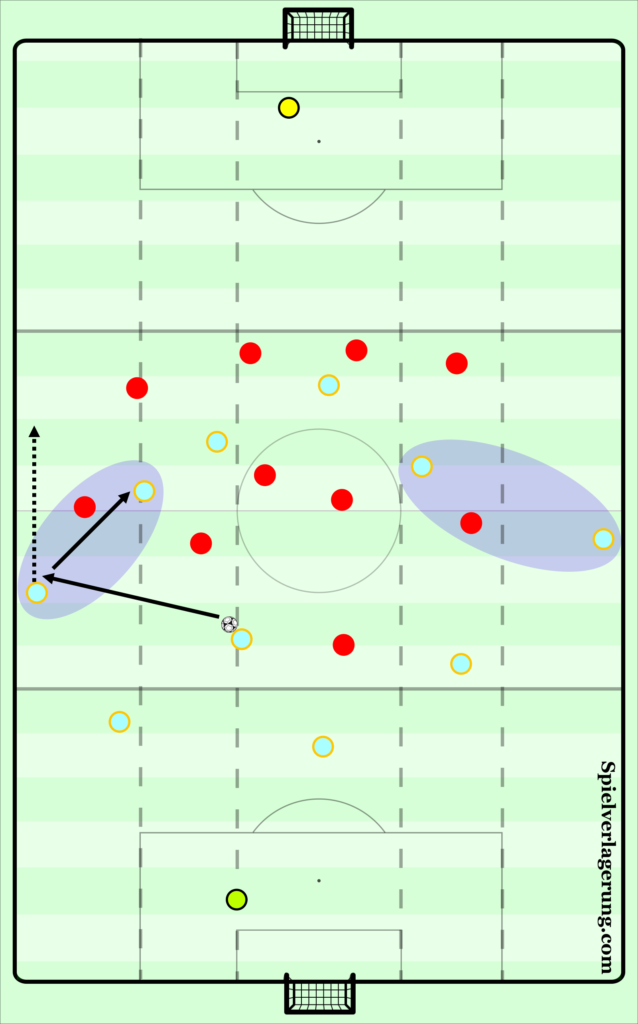
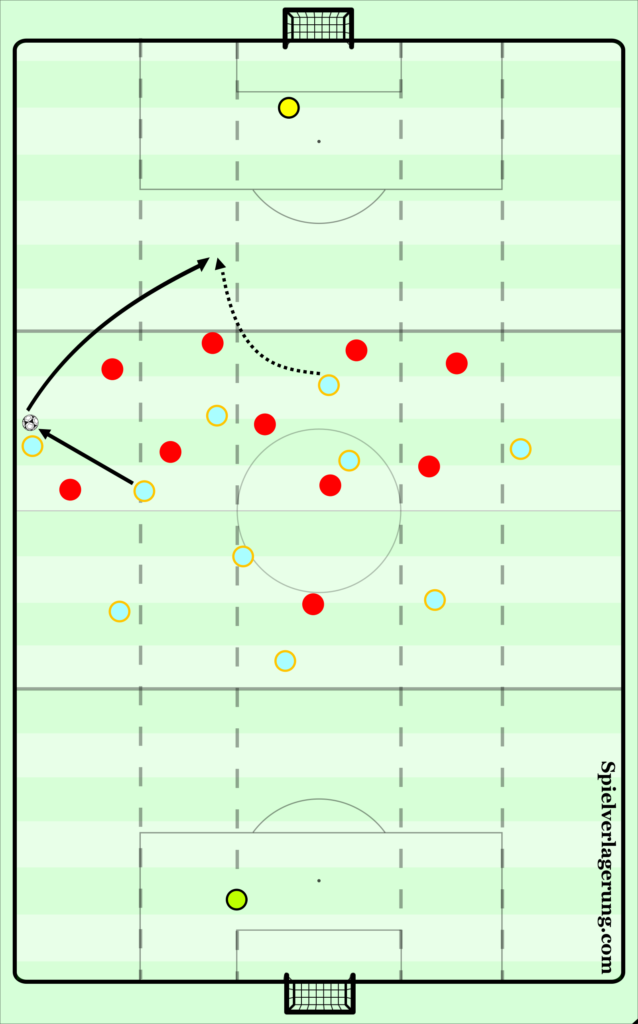
However, there is an important tactical limitation to highlight, despite the clear benefits as an alternative strategy when central areas are congested or when the opposition are more offensively inclined due to the opening up of spaces to exploit, the effectiveness of this strategy severely diminishes when playing against a back 3 or even a low block (in formations that “double-up” out of possession in wide areas). This is simply caused by the reduction of available space for Lazio to exploit and when playing against a back three there is an additional defender who can step into the half-space to restrict the wide No. 8. Although, it remains an extremely effective component of Lazio’s build-up play and should not be underestimated, though it does highlight the necessity for a variety of accessible strategies for Lazio to implement to remain successful.
Utilising the Fluid “1-1” (AM & ST) and Immobile’s Role in Attacking Play
Despite this piece’s primary focus upon Lazio’s build-up strategy (which would cover the first two thirds of the pitch as it has above), it would be insufficient to not at least appreciate the variety of employed strategies within the final third. The key element within this is the fluidity to create either one or two in last line situations via the flexible “1-1” created by the attacking-midfielder at the top of the midfield diamond (Correa/Caicedo) and striker (Immobile), as well as a micro-focus upon the extended freedom of movement that Immobile possesses to create overloads within the final third.
There has already been consideration of the important role the “1-1” plays, with the deeper attacking-midfielder becoming the “extra man” of a central midfield diamond that allows Lazio to create a 4v3 overload against teams that line up with three central midfielders, whilst the remaining striker stays in a higher position to occupy opposition defenders to restrict their ability to step in and press (which would create a balanced 4v4) see the above section for this explanation. However, the level of fluidity within this was overlooked and it is important to consider the frequent rotations that occur between the “1-1” to disrupt and prevent the opposition from defending with specific focus upon penetrating beyond the defensive line. The below depictions may seem basic, but as centre-backs it is difficult to consistently track these vertical rotations for the entirety of a game, with Lazio’s intention to exploit their opponents in one of the ways shown below upon a lapse of concentration. The first objective of these rotations is to create space for the deeper of the “1-1” to receive following rotation without immediate pressure and play directly past the opposition’s defensive line, with the higher striker making a penetrative run beyond the defence upon the deeper player receiving as a trigger. The fundamental premise of this is that the centre-back who would be nearest to the player dropping in as part of the rotation does not follow and remain “in contact”, therefore allowing this player to receive and turn to play an attempted penetrative pass through to the other striker. However, if the player in question is followed as in the second graphic, it then opens upon the secondary opportunity to penetrate via a diagonal pass utilising the highest striker as a bounce player to “play round the corner” by receiving on the front foot to a forward run from either the deeper attacking-midfielder or even a third man run from often highly positioned No. 8’s (Milinkovic-Savic/Luis Alberto). These methods in isolation are in no means exhaustive, but once again in addition to the already explained roles of the “1-1” and wider plethora of attacking methods, present an effective strategy for penetrative play through vertical rotations.
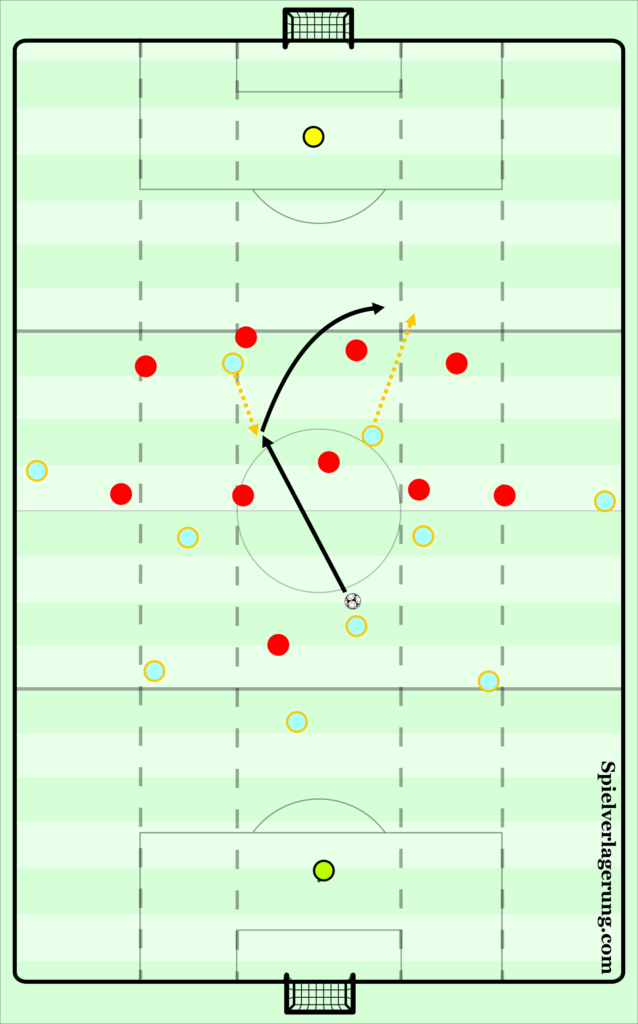
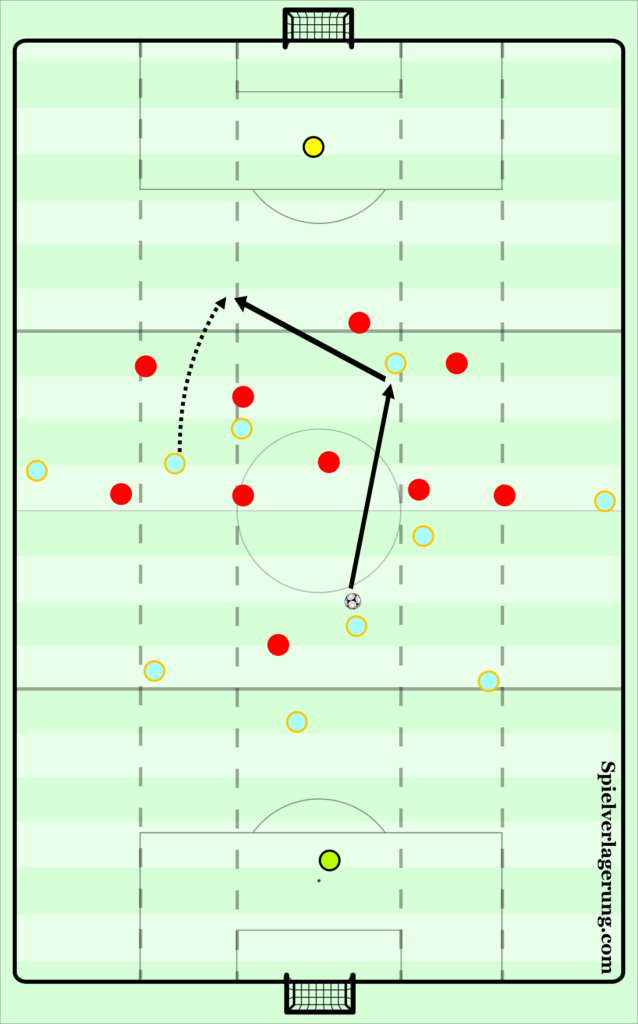
A different aspect of Lazio’s attacking play is the ability to create an attacking two in last line scenarios, particularly useful if the opposition are playing within a rigid defensive structure or particularly as a compact back three, in order to lock off defenders and create space between the opposition’s midfield and defensive line for combinations and movement to penetrate. The below example of their goal against Spal exemplifies this directly, despite playing a back three in an attempt to counter Lazio’s attacking prowess, Tomovic and Strefezza had been drawn out as the near-side half-back and wing-back leaving Immobile and Caicedo “locked off” in a 2v2 against Felipe and Bonifazi whilst Milinkovic-Savic has positioned himself cleverly beyond the opposition’s midfield line (creating a situation that would actually be more representative of playing against a back four). As possession is played into Milinkovic-Savic, Immobile uses this as a trigger to make a 3rd man double movement into the vacated space which drags Felipe out of Spal’s compact structure and opens up exploitable space within the near-side half space for the second phase (Immobile drops in as a rotational movement with Milinkovic-Savic occupying the space that Caicedo could have used to perform the same action). If Caicedo/Immobile were not locked off as a two and rather played as a “1-1”, this pattern would be unsuccessful as one of Felipe/Bonifazi would be able to press upon the pass into Milinkovic-Savic as there would be sufficient cover for the remaining striker, whilst the space created for Immobile’s double movement would be occupied and restrict this eventuality. It is also a pertinent consideration that Lazzari and Lulic’s extreme width enables the space be created within this half-space as they ensure the aforementioned near-side half-back/wing-backs (Strefezza/Tomovic/Reca) aren’t able to retain compactness with the rest of the back line.
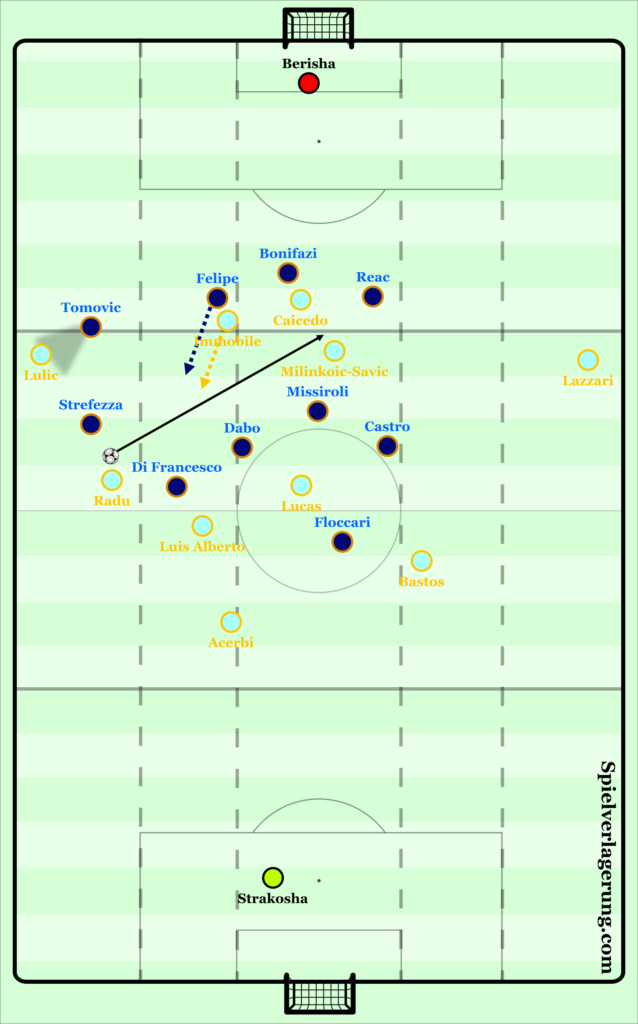
Once possession has reached Milinkovic-Savic, following a quick combination with Caicedo who plays the pass through, Immobile makes the run into the exposed half-space created by his initial movement in the first phase to progress and receive beyond Spal’s defensive line. Upon this, Milinkovic-Savic and Caicedo both make differing movements whilst the latter receives and curls a shot past Berisha. This only extends the understanding of Lazio’s attacking strategy within the final third, similarly to deeper play Lazio look to combine (albeit in much tighter areas in the final third) with frequent runs beyond the opposition and particularly in the half-spaces between central and wide defenders to exploit the opposition. This is where Immobile/Caicedo’s positional movement is integral, the flexibility to go two high and lock off opposition defenders to create space for Milinkovic-Savic and the subsequent space for Immobile’s double movement causes disruption to the opposition’s rigid structure and ultimately leads to opportunities to exploit space, as shown with the example below displaying particularly effectiveness against an opposition back three. Though, this strategy works as effectively against an opposition back four, creating the same proposition whilst freeing up the No.8 (Milinkovic-Savic/Luis Alberto) to make forward runs beyond the opposition’s last line whilst Immobile/Caicedo retain the freedom the be the receiving player once they drop in as an alternate adaptation.
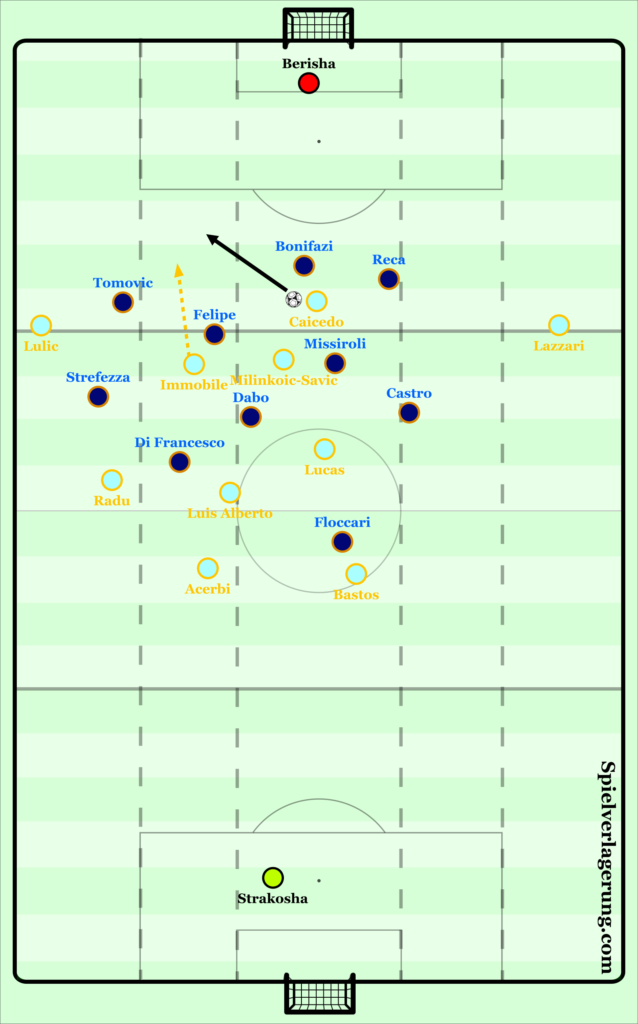
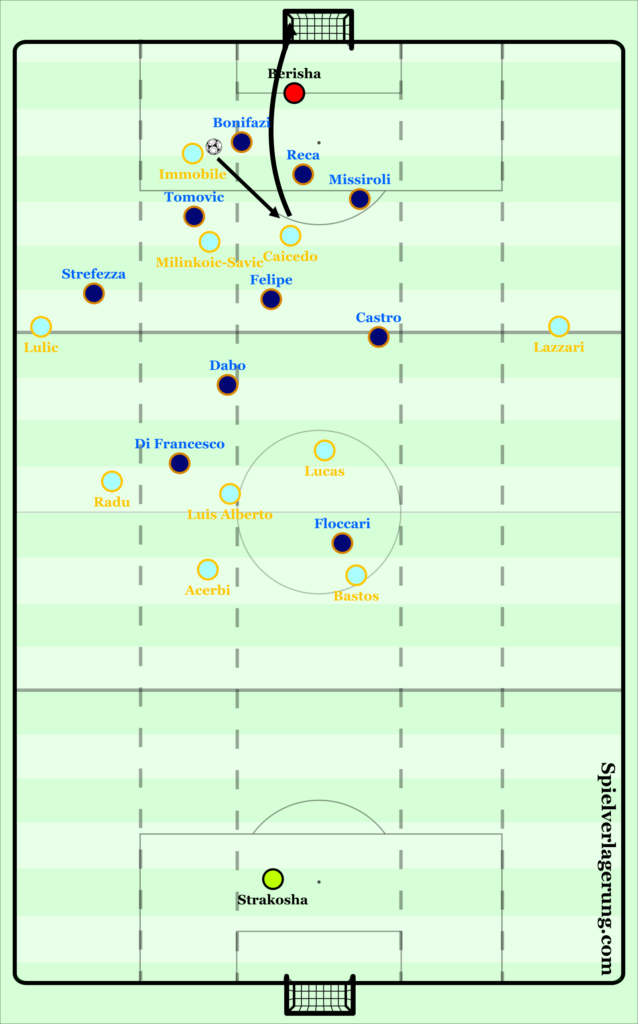
Creating two high in last line scenarios also has secondary benefits, with other outcomes available if the pattern highlighted above isn’t chosen. As implied before, an important part of Lazio’s build-up is creating a wide 2v1 utilising the wider No. 8 and wing-back. This can be seen as a situational benefit of playing two high as well, with the opposition central-defenders “locked out” in effect, creating space to be exploited in wider areas (this would be a second priority, as Lazio always look to penetrate centrally primarily). This allows possession to be played diagonally across to the opposite wing-back with the opposition full-back/wing-back underloaded against Lazzari and the 3rd man forward run of Milinkovic-Savic. The opportunity to play this pattern once again arises from the No. 8’s (Milinkovic-Savic’s) position beyond the midfield line, enabling him to be un-tracked with his penetrative run beyond the opposition’s defensive line into the half-space. This is unavailable if the opposition midfield maintain a goal-side position, as the No. 8 can be tracked as possession switches, whilst it is also unavailable if Lazio were structured within an attacking “1-1” with the near-side central defender able to transition across and deny progression in the exploited half-space. This produces a useful variant to Lazio’s largely central attacking play, whilst also expressing the importance of having fluidity to push two high and subsequently create space in other areas.
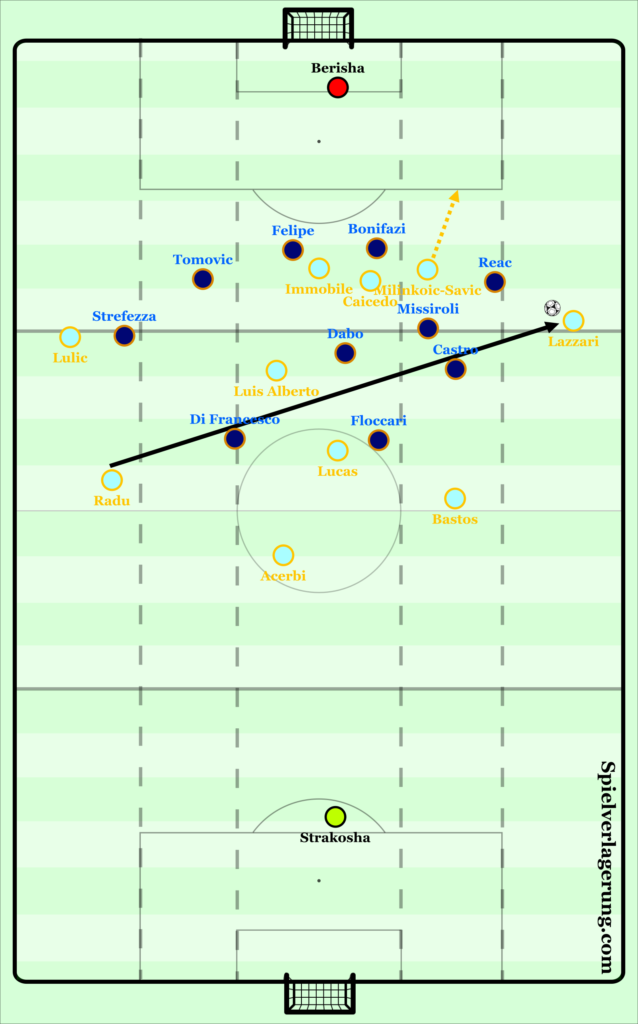
However, as seen with vast majority of play throughout Lazio’s build up, attacking in such a compact central manner does pose problems as it allows the opposition (if done effectively) to screen and zonally mark “spaces” as opposed to marking “players”, arguably with the benefit of using less players than a man-orientated approach. This approach has been used by Lecce amongst other teams and can be demonstrated through the graphic below. Lazio have secure possession on the verge of the final third, whilst Lecce (playing a 4-3-1-2) have dropped into a low block with specific focus upon the central midfielders screening in front of the back four. The advantage of this is that midfielders can successfully position themselves to screen passes into the striker whilst also retaining the ability to travel and press onto the more advanced midfielders Correa who has dropped in to create the “1-1”. This was cleverly adapted by Lecce who with a three man central midfielder operated a fluid system where two midfielders remained as a screen whilst the remaining one was able to travel out to press as the nearest man should it become applicable, or they could even remain as a screening trio if they wished. As a result, the central-defenders can be more aware of runs into the half-space whilst the full-backs maintain a narrower position to also prevent this distance between themselves and the centre-backs from widening (they allow play to go out wide and opt to stay in an organised structure unlike Spal). The attacking-midfielder and the strikers can also pressure deeper Lazio players such as Lucas and their defenders restricting the ability they have to play penetrative vertical passes. Even if possession is switched, Lecce can retain their shape easily and rather force Lazio’s hand as to challenge them to find a way through. This limited the effectiveness of Lazio’s heavily central and vertical based approach, forcing them to devise new adaptations to attack.
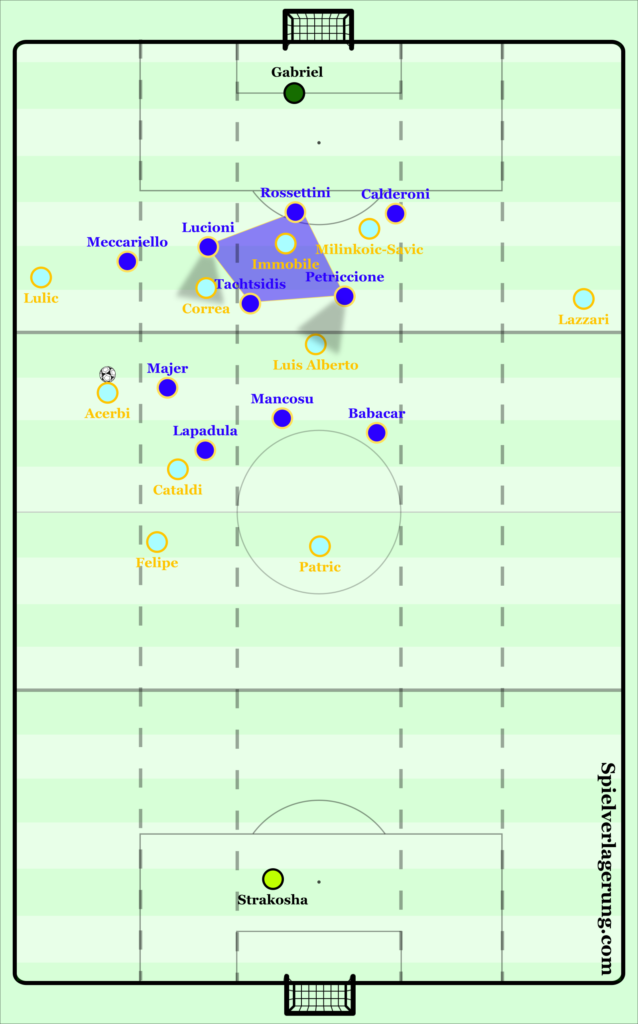
This is where a micro-focus upon Immobile’s freedom of movement becomes essential, extending further than his structured vertical rotation and double movements already displayed within this section to break down opposition defensive block’s and provoke central penetration (if the prior methods have been unsuccessful). With the flexibility to move between lines, Immobile in this scenario is able to drop deeper than the opposition’s midfield line, creating an overload within deeper areas of build-up that can benefit Lazio either by receiving and travelling past the midfield line to break lines or by receiving deeper to play a penetrative forward pass into Correa or advanced No. 8’s (the No. 8’s would make 3rd man forward runs upon the trigger of Immobile receiving in this instance). If Immobile receives and is under pressure, the 3v2 ensures that he can play across to Luis Alberto/Milinkovic-Savic to retain possession and ensure Lazio can positively progress beyond the opposition’s midfield line. The rationale of why this is so effective is that it causes more positional shift than if Correa was to produce the same movement. If Correa dropped deeper it is more likely to be tracked as the opposition central-midfielders have more awareness of where he is, given that his resting position is often in-front/on-line with them. However, Immobile’s movement comes from a blind-side starting position and is very unlikely to be tracked with Lazio able to seize upon momentary lapses of concentration/communication/awareness between the opposition’s defensive and midfield line to create a deeper overload (if the central-defenders did track him, it would leave the opportunity to penetrate the last line either through a direct pass or diagonal combinations as shown previously in the piece). As a consequence, it provides Lazio with a further modification to break down teams in deeper blocks and particularly those who utilise central-midfield screening approaches to prevent such dangerous central penetration, contributing to a comprehensive array of attacking measures to ensure potency in the final third.
Conclusion
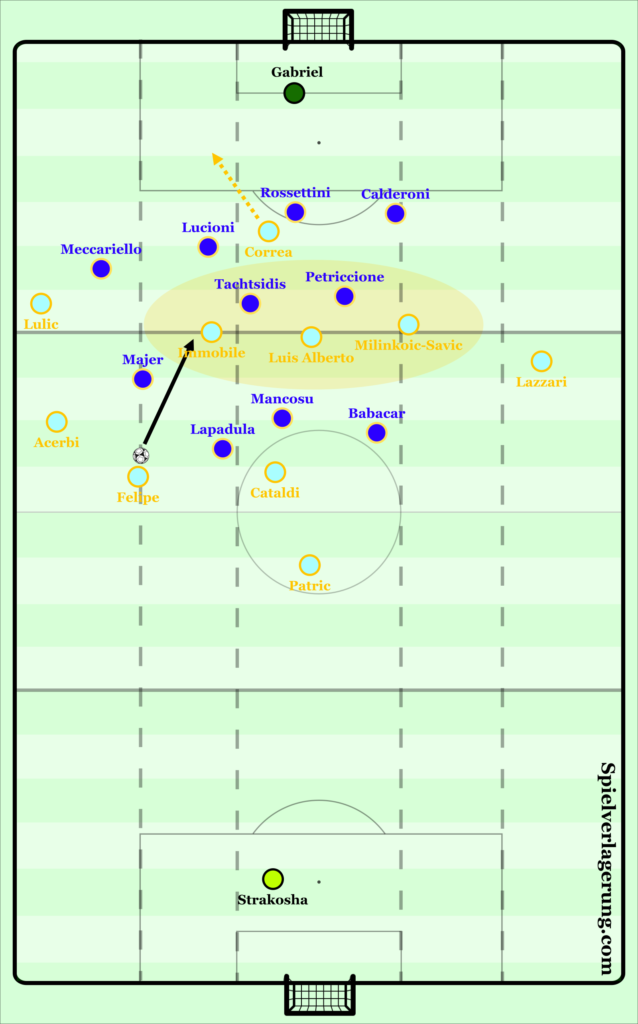
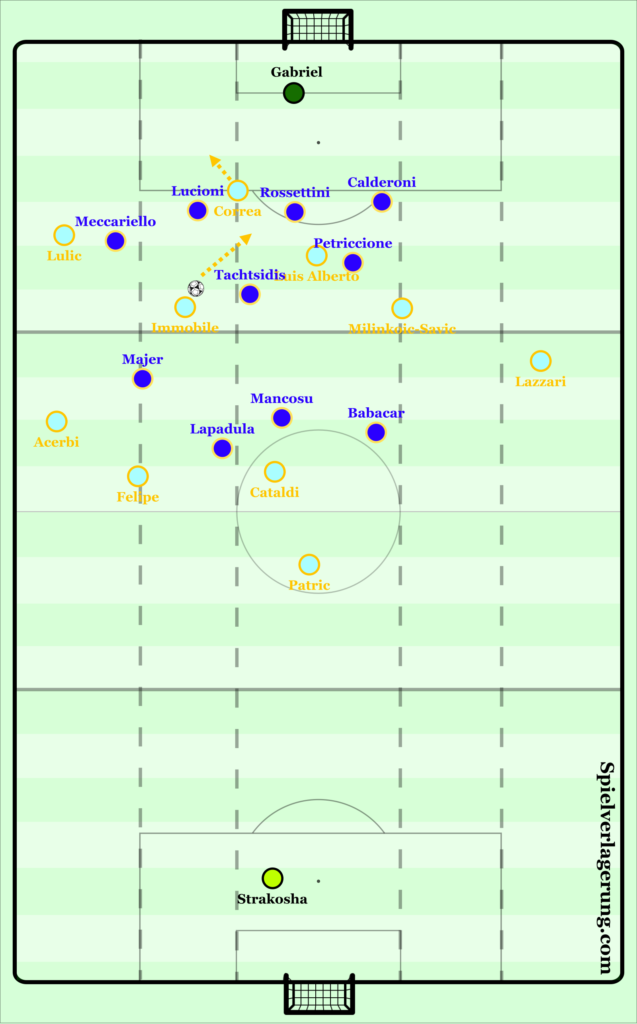
Lazio certainly performed way above their expectations during the 2019-20 season, yet much more impressive is the array of strategies they employed through build-up to ensure they consistently managed to penetrate and create against almost every opponent. Simone Inzaghi has built a formidable attacking team and it will be intriguing whether these players can perform once again at an elite level within the Champions League. The inkling is that this will hinge upon retaining their attacking potency and whether they can continue to adapt in the face of much more challenging opponents and various strategies to stifle them. Regardless, it will be interesting to observe it unfolding and following Lazio to see how they proceed in this season’s endeavours.
Keine Kommentare vorhanden Alle anzeigen